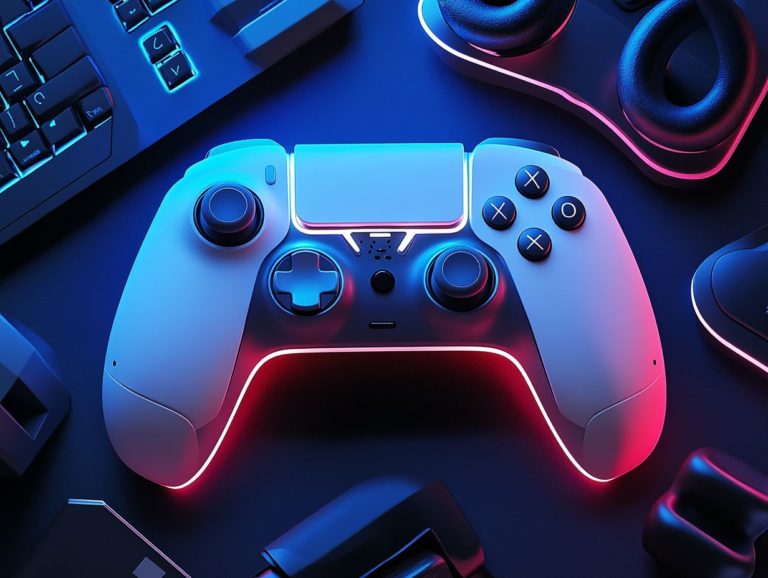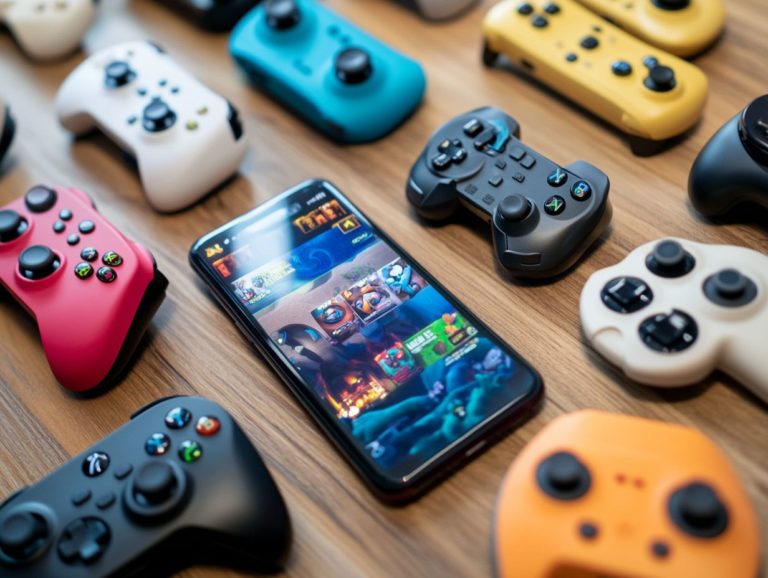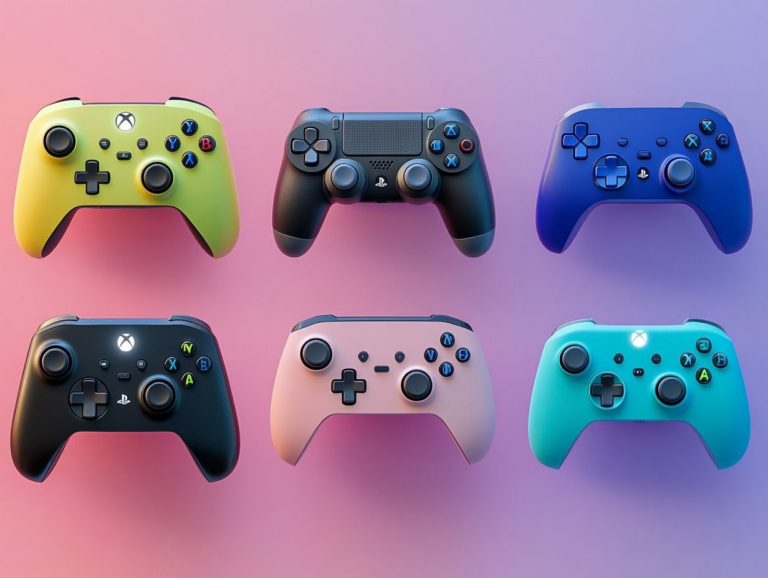comparing gamepad layouts: which is right for you?
Choosing the right gamepad layout can elevate your gaming experience. With countless options on the market, it s easy to feel overwhelmed.
This article delves into various gamepad layouts traditional, asymmetrical, and customizable designs guiding you through their distinctive features and benefits.
As you navigate your options, consider crucial factors such as comfort, game compatibility, and your budget.
By the end, you ll know exactly which layout fits your gaming style!
Contents
- Key Takeaways:
- Understanding Gamepad Layouts: Why They Matter
- Types of Gamepad Layouts
- Asymmetrical Layouts
- Customizable Layouts
- Factors to Consider When Choosing a Gamepad Layout
- Gaming Preferences and Comfort
- Pros and Cons of Each Gamepad Layout
- Frequently Asked Questions
- What are the different types of gamepad layouts to choose from?
- What is the D-pad layout and who is it best suited for?
- How does the joystick layout differ from the D-pad layout?
- What is the hybrid layout and how does it combine features from both D-pad and joystick?
- Which gamepad layout is right for me?
- Can I customize my gamepad layout?
Key Takeaways:
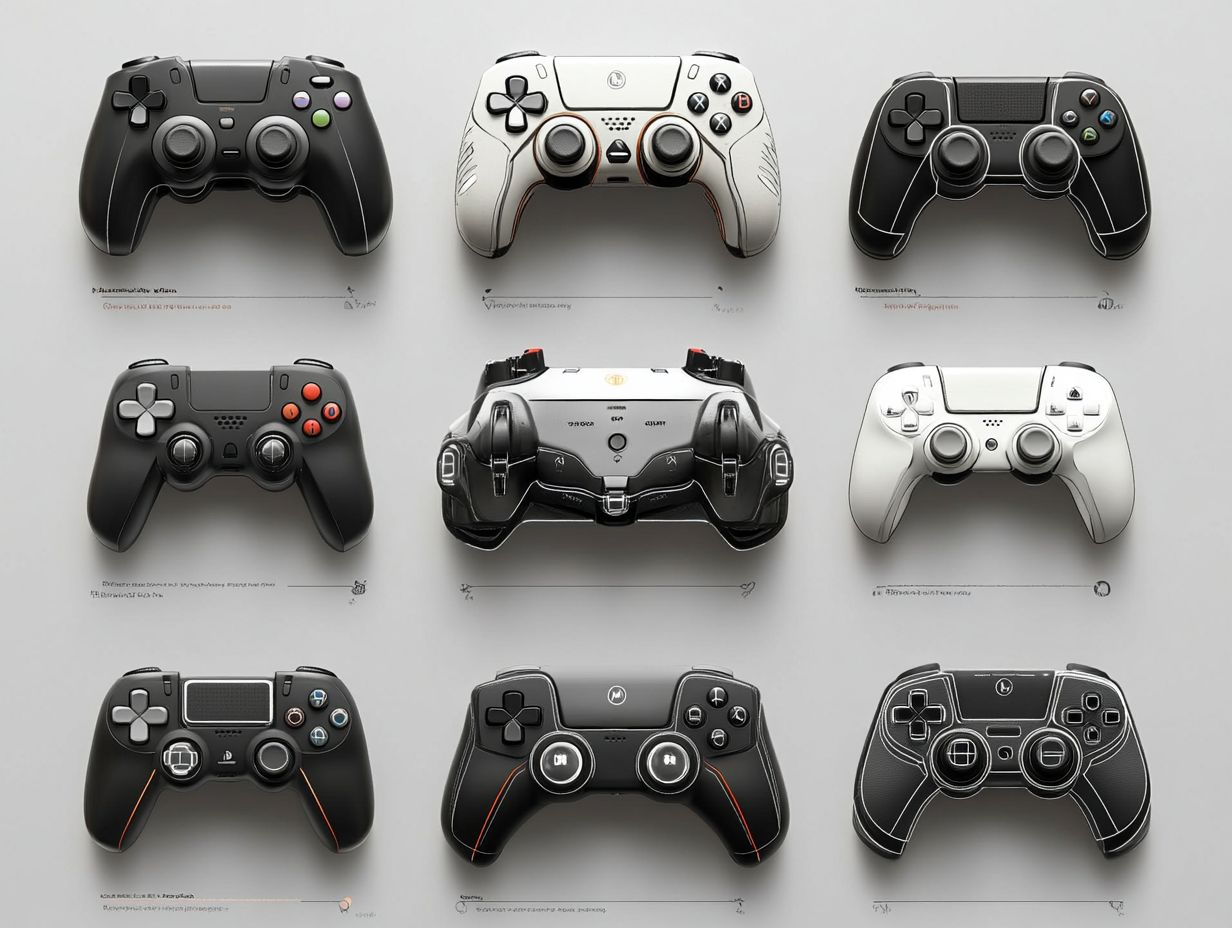
When choosing a gamepad layout, consider your gaming preferences and comfort level to find the perfect fit. To make an informed choice, it’s helpful to know how to choose the right gaming controller and ensure compatibility with your favorite games to fully utilize the benefits of your chosen layout. Traditional, asymmetrical, and customizable layouts all have their pros and cons, so weigh them carefully before making a decision.
Understanding Gamepad Layouts: Why They Matter
Gamepad layouts are crucial designs that shape how gaming controllers operate. They enable you to engage seamlessly with your favorite titles on platforms like the Xbox Series X, Xbox Series S, and Windows PC.
These layouts include various elements, such as button placement and joystick positioning, which enhance your gameplay experience. Features like customizable buttons and audio controls also play a significant role.
Understanding these layouts can profoundly influence your performance, especially in competitive settings where tailored configurations may give you an edge over your opponents.
Types of Gamepad Layouts
Gamepad layouts are categorized into three types: traditional, asymmetrical, and customizable. Each type is designed to make your gaming more comfortable and enjoyable.
Traditional layouts are the familiar options found in controllers like the Xbox Wireless Controller. In contrast, asymmetrical layouts push boundaries with innovative designs aimed at competitive players.
If you crave personalization, customizable layouts allow you to map buttons according to your preferences. This enhances your control, especially in fast-paced genres like first-person shooters.
Traditional Layouts
Traditional layouts, like those in the Xbox Wireless Controller, feature a symmetrical design that has become the gold standard for many beloved gamepads. These layouts typically have a button arrangement crafted for intuitive access across various game genres.
The familiarity of these designs allows both casual and competitive gamers to adapt quickly. This design enhances usability and plays a crucial role in your overall comfort during long gaming sessions.
The strategic placement of analog sticks and triggers aligns with your natural hand positioning. This minimizes strain and boosts endurance during gameplay.
With features like textured grips and adjustable sensitivity settings, controllers like the Xbox Wireless Controller are a top choice for gamers who value precision and feedback.
Together, these elements create an immersive experience tailored to different gaming styles. A traditional layout can significantly shape your gameplay preferences and overall satisfaction.
Asymmetrical Layouts
Asymmetrical layouts in gaming controllers break away from traditional designs by positioning the joystick and buttons off-center. This offers a unique ergonomic advantage that many competitive gamers favor.
These layouts, often found in controllers like the Scuf Instinct Pro, let you use customizable rear buttons for quick actions. This boosts your reflexes and overall gameplay performance. If you dive into fast-paced titles, especially first-person shooters, you ll find these layouts beneficial, helping you keep control while executing complex maneuvers.
This distinct design promotes a more comfortable grip and reduces strain during marathon gaming sessions. The intuitive placement allows quick access to frequently used controls without sacrificing precision.
Additionally, the adaptability of these controllers lets you customize them to suit your playstyle, giving you a significant edge in competitive scenarios.
Many professional players note that controllers with asymmetrical layouts enhance their in-game awareness and responsiveness key elements that can influence the outcome of a match.
These innovative designs have carved out a special place in esports, becoming essential tools for serious competitors.
Customizable Layouts
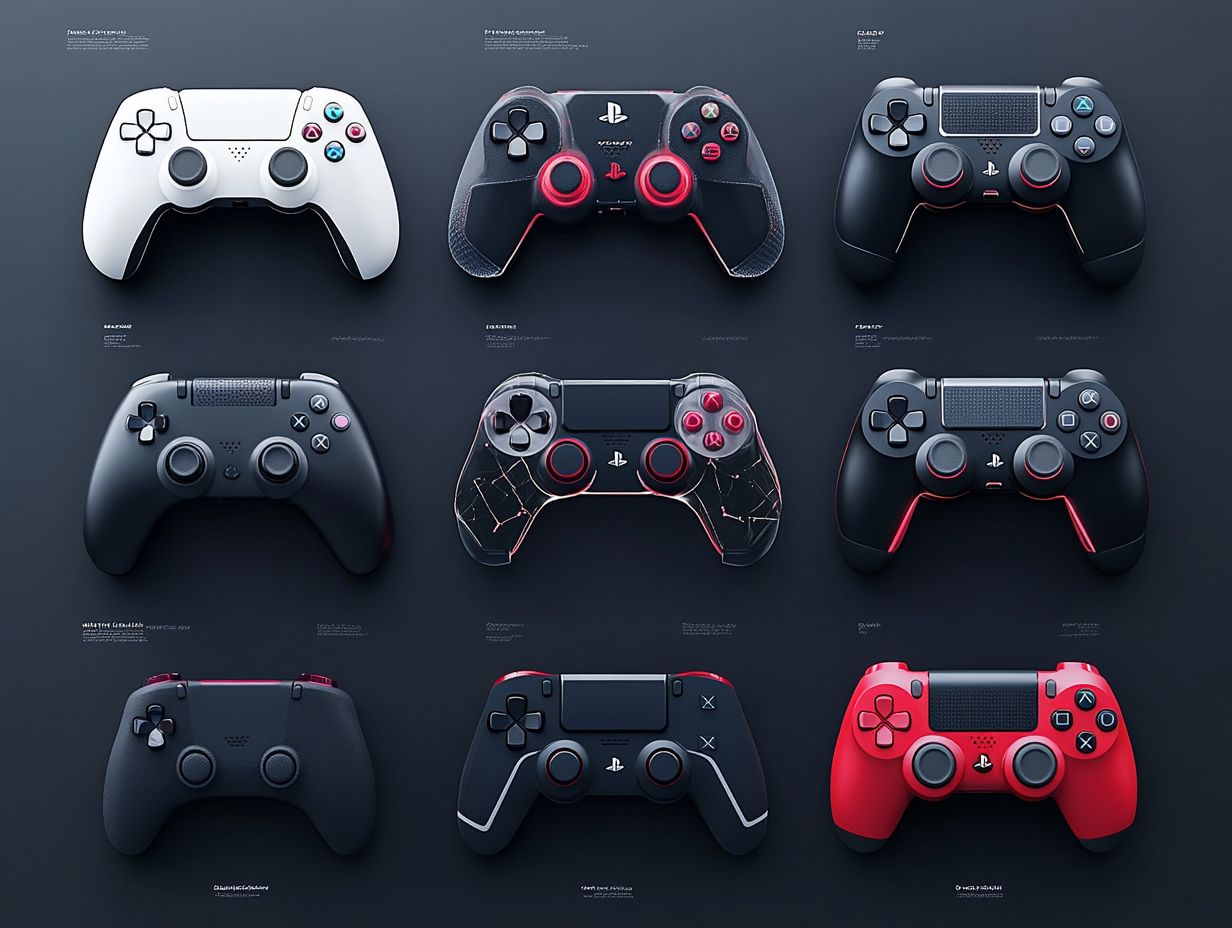
Customizable layouts in gaming controllers allow you to tailor your gaming experience by adjusting button configurations and sensitivity settings through software. This flexibility is especially beneficial for gamers who value personalized setups, enabling you to assign functions like audio controls and in-game actions to easily accessible buttons.
Take the Xbox Elite Series 2, for example. It offers extensive customization options, helping you find your optimal comfort level during intense gaming sessions. These modifications go beyond personal preference; they can greatly enhance your gameplay performance.
If you’re into first-person shooters, you might prioritize rapid access to weapon swaps or grenade throws. If racing games are your thing, quick adjustments for throttle responses can make a huge difference.
It doesn t stop with the Xbox Elite Series 2. Other controllers, such as the Razer Wolverine Ultimate and SCUF Gaming s offerings, further highlight this trend. These devices allow meticulous button remapping and introduce features like interchangeable thumbsticks and trigger stops.
As the gaming community continues to evolve, customizable layouts are becoming increasingly essential. This ensures that you can fully immerse yourself in the gaming universe without compromise.
Factors to Consider When Choosing a Gamepad Layout
When selecting a gamepad layout, consider several factors to optimize your gaming performance.
Your gaming preferences, comfort, compatibility with various titles, and budget constraints all significantly influence your choice. Evaluate your comfort levels with different controller designs, as specific layouts can either enhance or hinder your performance on the Xbox Series X, Xbox Series S, or Windows PC.
Understanding how different gamepad layouts align with specific genres like first-person shooters or role-playing games is critical to making an informed decision.
Gaming Preferences and Comfort
Understanding your gaming preferences and comfort is vital when selecting the right gamepad layout. This significantly impacts your performance and enjoyment. To make an informed decision, consider how to choose the right controller for your gaming style. Every gamer has a unique playstyle, and factors like hand size and grip preference can sway your choice between traditional and asymmetrical layouts.
Choosing a controller that feels comfortable and intuitive is essential for enhancing your overall gaming experience.
If you lean toward traditional layouts, you might find that the symmetrical positioning of thumbsticks provides a sense of familiarity, making it easier to master complex controls in competitive situations. On the other hand, if you prefer asymmetrical layouts, you’ll likely appreciate the ergonomic benefits, allowing smoother movements and less wrist strain during marathon sessions.
Recognizing these preferences not only highlights the diversity of gaming styles but emphasizes the importance of selecting a gamepad that aligns with your ergonomic needs. This ultimately leads to a more immersive and enjoyable gaming journey.
Compatibility with Games
Compatibility with games is a vital consideration when selecting a gamepad layout. Not all controllers are optimized for every title on platforms like the Xbox Series X or Xbox Series S.
Certain genres such as first-person shooters or sports games thrive with specific layouts. This ensures you can execute commands with precision and enjoy a seamless experience.
For instance, opting for a controller with customizable buttons or audio controls can significantly enhance your gameplay. This is especially true in competitive settings.
Your choice of gamepad profoundly impacts your performance. A layout designed for racing games might feature triggers for improved acceleration control. In contrast, fighting games often excel with pads that have a finely-tuned D-pad arrangement.
As you dive into popular titles like ‘Call of Duty’ or ‘FIFA,’ layouts with programmable macro functions give you a competitive edge. These functions allow you to automate multiple actions with a single button press, enabling quicker reaction times and more strategic maneuvers.
Thus, understanding how a specific control scheme interacts with various genres isn t just about personal preference; it s key to taking your gaming to the next level!
Price and Availability
When selecting a gamepad layout, price and availability significantly influence your options. Premium choices like the Scuf Instinct Pro boast advanced features and customizable elements.
Budget-friendly alternatives, such as the PowerA Enhanced Wired Controller, deliver remarkable value without straining your finances. Consider your budget and the market s availability of these controllers for an informed decision.
As a budget-conscious gamer, you often weigh the trade-offs between cost and performance. A lower-priced gamepad might lack high-end features, such as programmable buttons or ergonomic designs, which enhance gameplay.
Investing in a premium controller can improve responsiveness and longevity, appealing to those who take gaming seriously. Availability also plays a crucial role; limited-release premium models can disappear quickly, compelling you to act fast!
By carefully considering both your financial investment and functional benefits, you can significantly enhance your overall satisfaction and user experience in gaming.
Pros and Cons of Each Gamepad Layout
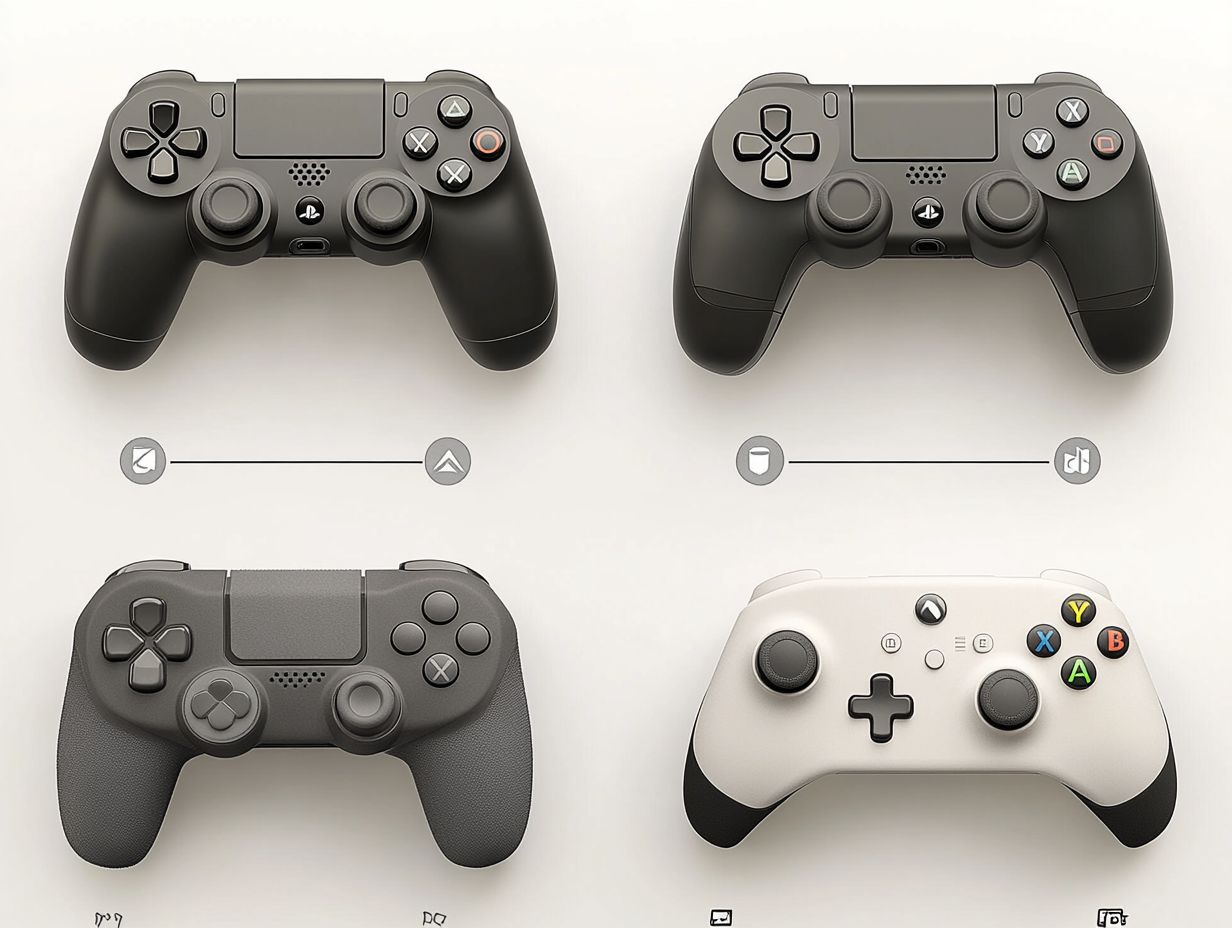
Each gamepad layout presents a unique array of advantages and disadvantages that significantly influence your gaming experience.
Traditional layouts often earn praise for their familiarity and ease of use, making them a go-to choice for casual gamers. Asymmetrical layouts boast innovative designs tailored for competitive players seeking a performance edge.
If you re considering customizable layouts, they offer remarkable flexibility. However, they often come with a premium price tag.
It’s crucial to weigh these factors carefully to select the controller that best aligns with your gaming needs and preferences.
Advantages and Disadvantages of Traditional, Asymmetrical, and Customizable Layouts
The advantages and disadvantages of traditional, asymmetrical, and customizable layouts bring unique considerations for you when selecting your gaming controllers. This choice becomes increasingly crucial as you seek to optimize your gameplay experience.
Traditional layouts, with their intuitive design, are particularly welcoming for novice players, enabling a swift understanding of the controls without an overwhelming feeling.
On the other hand, asymmetrical layouts cater to seasoned gamers who thrive on tactical precision. They offer swift reflexes and enhanced maneuverability in competitive scenarios. However, this performance-focused design may sacrifice comfort for some casual players.
Customizable layouts shine for their versatility, allowing you to tailor button configurations to suit your gameplay style. Yet, they can present a challenge if you re not well-acquainted with the technology, introducing a learning curve that might hinder immediate enjoyment.
Final Considerations and Recommendations
Selecting a gamepad layout requires considering your personal needs and comfort. Your gaming performance will improve when you reflect on your unique play style.
Tactile feedback and button placement are vital for efficient gameplay. Explore layouts designed for your favorite game genres to optimize your experience.
If you’re into first-person shooters, pick a layout that allows for quick responses. For role-playing games, choose a configuration that prioritizes comfort during long sessions.
By weighing these considerations and testing options, you can find a gamepad layout that enhances your gaming enjoyment and skill.
Frequently Asked Questions
Here are some common questions about gamepad layouts that can help guide your choices.
What are the different types of gamepad layouts to choose from?
There are three main types of gamepad layouts: the directional pad (D-pad) layout, the joystick layout, and the hybrid layout. Each offers a unique way to control your games, and understanding these differences is important.
What is the D-pad layout and who is it best suited for?
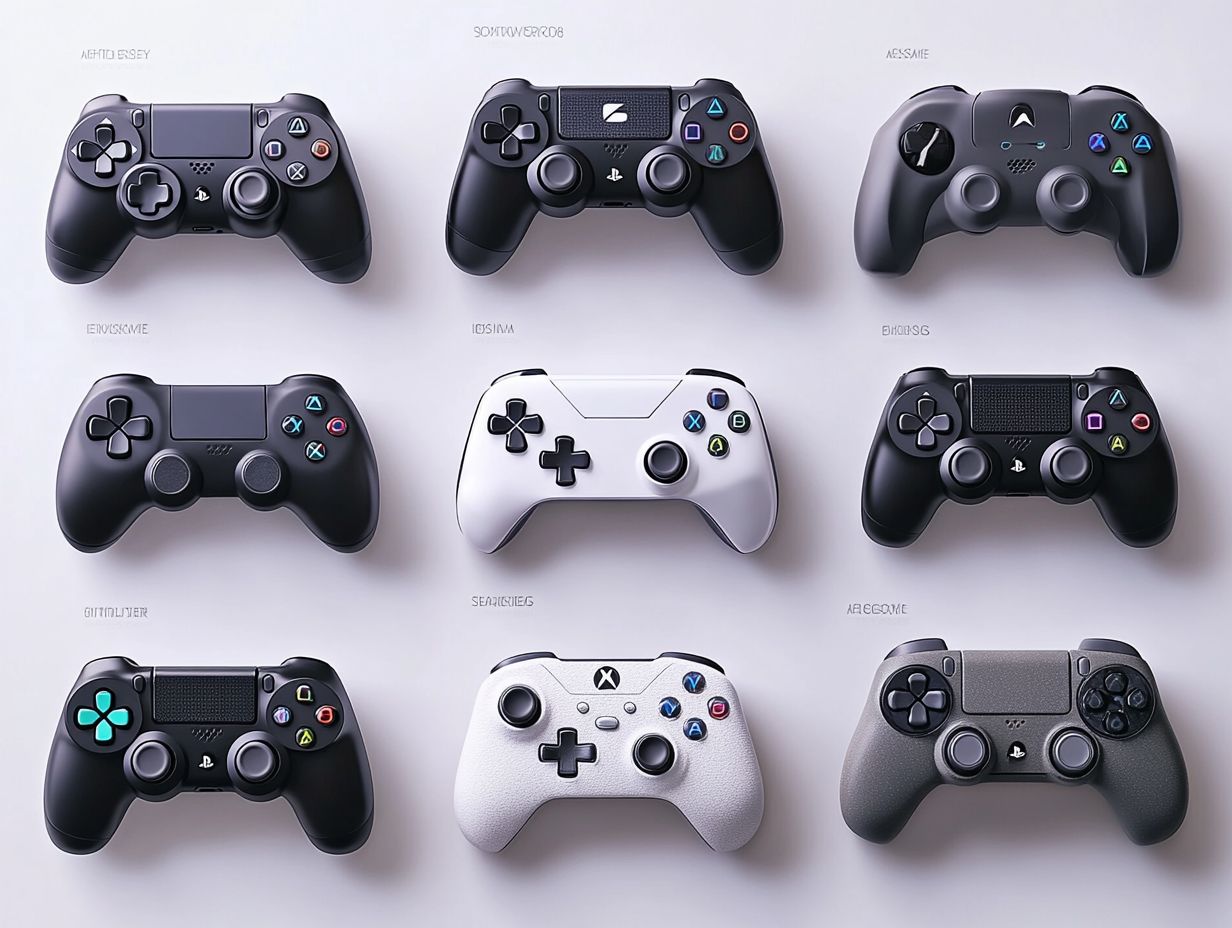
The D-pad layout has a directional pad for movement and four buttons for actions. It’s best for 2D platformers and fighting games that need precise input.
How does the joystick layout differ from the D-pad layout?
The joystick layout uses a single analog stick for movement instead of a D-pad. This is ideal for 3D games that require smooth movement and camera control.
What is the hybrid layout and how does it combine features from both D-pad and joystick?
The hybrid layout offers both a directional pad and an analog stick. It’s great for players who want the precision of a D-pad for some actions and the fluidity of a joystick for others.
Which gamepad layout is right for me?
Your ideal gamepad layout depends on the types of games you play and your personal preferences. Try different layouts to find which feels most comfortable and intuitive.
Can I customize my gamepad layout?
Yes! Many gamepads allow customization of button and stick mapping. Check your gamepad’s features before buying if customization is a priority for you.

